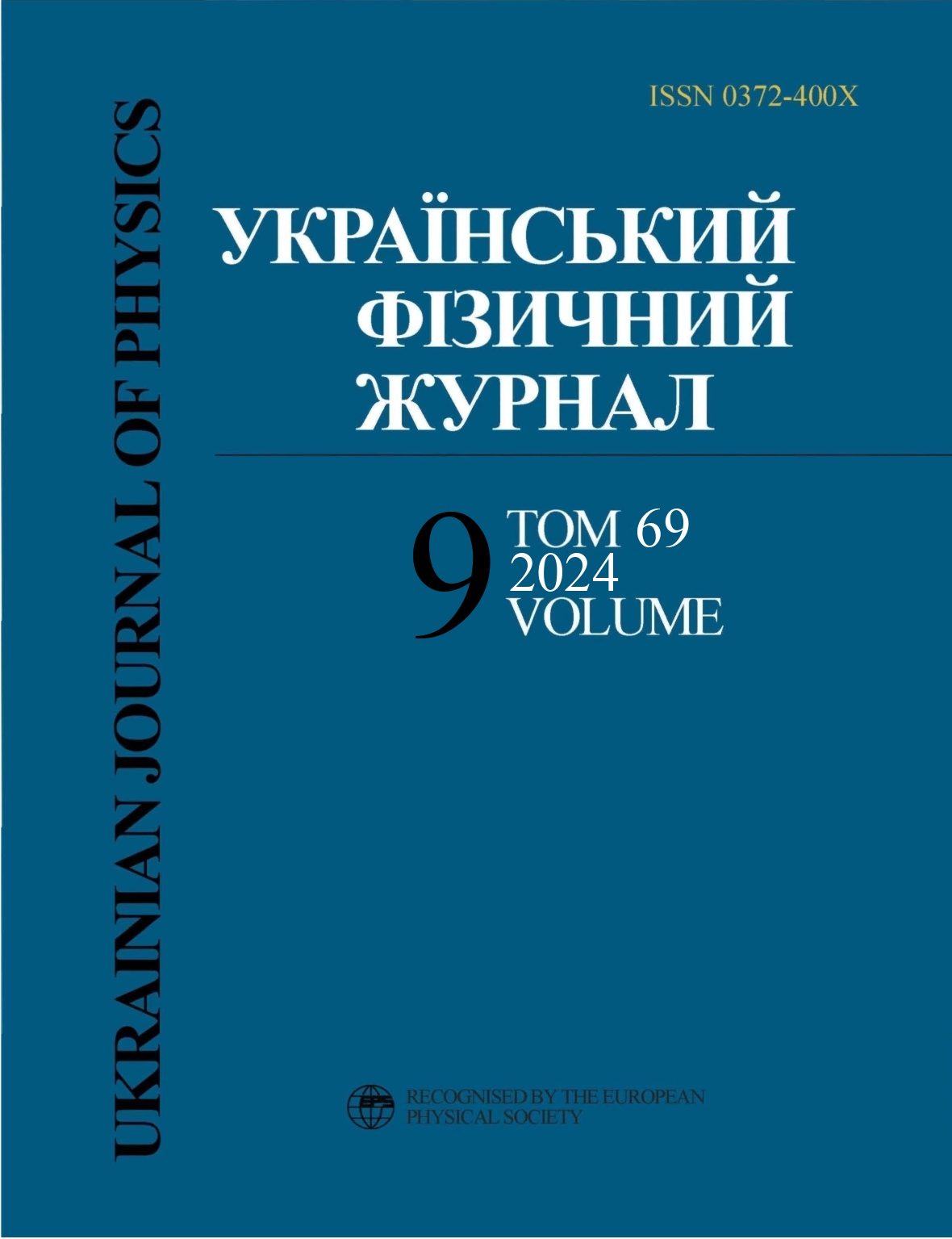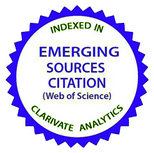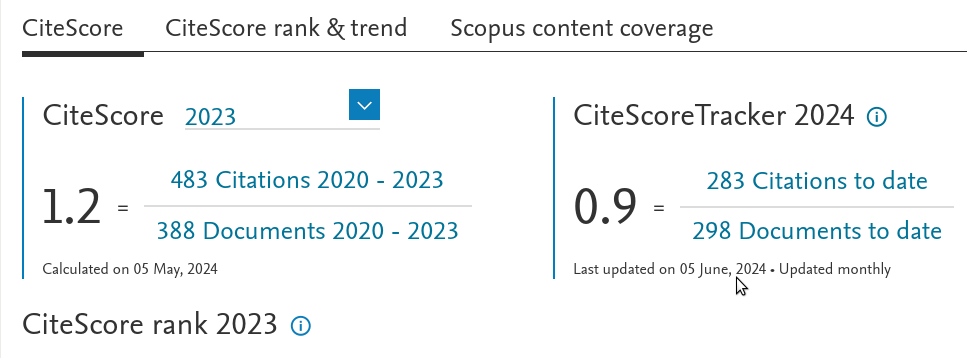Моделювання водних кластерів: спектральний аналіз, розподіл Гауса і лінійна функція часу
DOI:
https://doi.org/10.15407/ujpe69.9.632Ключові слова:
воднi кластери, розподiл Гауса, лiнiйна функцiя, спектральний аналiзАнотація
Нашi експериментальнi та теоретичнi дослiдження виявили наявнiсть кластерiв води в рiзних середовищах (особливо в гiдрофобних умовах), де переважають повiльнiшi взаємодiї iонiв водню. Ключовi методи, такi як ядерний магнiтний резонанс (ЯМР) i iнфрачервона Фур’є-спектроскопiя (IЧФС), вiдiграли вирiшальну роль у нашому розумiннi цих кластерiв, розкриваючи їх потенцiйне застосування в медицинi. На стабiльнiсть i поведiнку цих кластерiв можуть впливати такi фактори, як присутнiсть iонiв металiв, що приводить до утворення стабiльних кластерiв. Цей потенцiал для медичного застосування повинен вселити надiю та iнiцiювати подальшi дослiдження. Крiм того, нашi дослiдження виявили, що воднi кластери проявляють характеристики дисипативних структур, демонструючи самоорганiзацiю пiд час фiзичних, хiмiчних або теплових змiн, подiбних до конвекцiйних комiрок Релея–Бенара. Ця динамiчна та показова поведiнка пiдтверджує уявлення про те, що роль води виходить за межi простої хiмiї, потенцiйно впливаючи на бiологiчнi процеси на фундаментальному рiвнi. Взаємодiя водних кластерiв з навколишнiм середовищем i здатнiсть пiдтримувати нерiвноважний стан через обмiн енергiєю ще бiльше пiдкреслює їхню складнiсть i значення як у природному, так i технологiчному контекстах. Фiльтрування води – це процес, який використовується для покращення її якостi. Ефект виникає внаслiдок реструктуризацiї водневих зв’язкiв i структурування водних кластерiв, бiльшiсть з яких є гексагональними. У наших дослiдженнях ми застосували воду, фiльтровану за патентованою швейцарською технологiєю EVOdrop.
Посилання
K. Oka, T. Shibue, N. Sugimura, et al. Long-lived water clusters in hydrophobic solvents investigated by standard NMR techniques. Sci Rep. 9, 223 (2019).
https://doi.org/10.1038/s41598-018-36787-1
A.D. Kulkarni. Unraveling hydrogen bonded clustering with water: Density Functional Theory Perspective. Book: Density Functional Theory - Recent Advances, New Perspectives and Appl. 10, 173 (2021).
https://doi.org/10.5772/intechopen.99958
K. Kristinaityte, L. Dagys, J. Kausteklis et al. NMR and FTIR studies of clustering of water molecules: From lowtemperature matrices to nano-structured materials used in innovative medicine. J. Mol. Liq. 235, 1 (2017).
https://doi.org/10.1016/j.molliq.2016.11.076
N. Sun, Z. Li, N. Qiu, X. Yu et al. Ab initio studies on the clathrate hydrates of some Nitrogen- and Sulfur-containing gases. J. Phys. Chem. A 121, 2620 (2017).
https://doi.org/10.1021/acs.jpca.6b11850
N. Yang, C.H. Duong, P.J. Kelleher, M.A. Johnson. Capturing intrinsic site-dependent spectral signatures and lifetimes of isolated OH oscillators in extended water networks. Nat. Chem. 12, 159 (2020).
https://doi.org/10.1038/s41557-019-0376-9
E. Kochanski, E. Constantin. Theoretical and experimental studies of the system Ca+(H2O)n for n =1 to 10. J. Chem. Phys. 87, 1661 (1987).
https://doi.org/10.1063/1.453229
H. Watanabe, S. Iwata. Molecular orbital studies of the structures and reactions of a singly charged Calcium ion with water clusters, Ca+(H2O)n. J. Phys. Chem. A 101, 487 (1997).
https://doi.org/10.1021/jp9617985
I.R. Ariyarathna, E. Miliordos. Geometric and electronic structure analysis of calcium water complexes with one and two solvation shells. Phys. Chem. Chem. Phys. 39 (2020).
https://doi.org/10.1039/D0CP04309E
A.A. Delgado, D. Sethio, E. Kraka. Assessing the intrinsic strengths of ion-solvent and solvent-solvent interactions for hydrated Mg2+ Clusters. Inorganics. 9, 31 (2021).
https://doi.org/10.3390/inorganics9050031
P. Wang, Y. Su, R. Shi et al. Structures and spectroscopic properties of hydrated zinc(II) ion clusters [Zn2+(H2O)n(n = 1-8)] by Ab initio Study. J. Clust. Sci. 34, 1625 (2023).
https://doi.org/10.1007/s10876-022-02277-8
A.K. Pathak, T. Mukherjee, D.K. Maity. IR spectra of carbonate-water clusters, CO−23(H2O)n: A theoretical study. Synthesis and Reactivity in Inorganic, MetalOrganic, and Nano-Metal Chem. 38, 76 (2008).
https://doi.org/10.1080/15533170701854148
R. Custelcean, N.J. Williams, Ch.A. Seipp. Aqueous sulfate separation by crystallization of sulfate-water clusters. Angewandte Chemie. 54 (36), 10525 (2015).
https://doi.org/10.1002/anie.201506314
W.W. Rudolph, G. Irmer. Raman and infrared spectroscopic investigations on aqueous alkali metal phosphate solutions and density functional theory calculations of phosphate-water clusters. Appl. Spectr. 61, 1312 (2007).
https://doi.org/10.1366/000370207783292037
K.-T. Chang, Ch.-T. Weng. (2006) The effects of an external magnetic field on the structure of liquid water using molecular dynamic simulation. J. Appl. Phys. 100, 043917 (2006).
https://doi.org/10.1063/1.2335971
I. Ignatov, I.K. Stankov. Parameters and effects of magnetic field and potassium carbonate in water, applications. Ukr. J. Phys. 69, 321 (2024).
https://doi.org/10.15407/ujpe69.5.321
Y. Gao, H. Fang, K. Ni. A hierarchical clustering method of hydrogen bond networks in liquid water undergoing shear flow. Sci Rep. 11, 9542 (2021).
https://doi.org/10.1038/s41598-021-88810-7
A.A. Chernyuk, V.I. Sugakov. Ordered dissipative structures in exciton systems in semiconductor quantum wells. Phys. Rev. B 74, 085303 (2006).
https://doi.org/10.1103/PhysRevB.74.085303
X. Zhu, Q. Zhou. Flow structures of turbulent Rayleigh-B'enard convection in annular cells with aspect ratio one and larger. Acta Mech. Sin. 37, 1291 (2021).
https://doi.org/10.1007/s10409-021-01104-z
V. Elia, R. Germano, E. Napoli Permanent dissipative structures in water: The matrix of life? Experimental evidences and their quantum origin. Curr. Top. Med. Chem. 15, 559 (2015).
https://doi.org/10.2174/1568026615666150225102531
B.D. Josephson. Possible role of Josephson tunneling in the operation of life. Physica Scripta 40, 786 (1991).
E. Del Giudice, G. Preparata, G. Vitiello. Water as a free electric dipole laser. Phys. Rev. Lett. 61, 1085 (1988).
https://doi.org/10.1103/PhysRevLett.61.1085
L. Montagnier, E. Del Guidice, E.G. Vitiello et al. Transduction of DNA information through water and electromagnetic waves. Electromagn Biol Med. 34,106 (2015).
https://doi.org/10.3109/15368378.2015.1036072
M. Scalia, P. Avino, M. Sperini et al. Some observations on the role of water states for biological and therapeutical effects. Inov. Biosysyt. Bioeng. 231, 149 (2018).
https://doi.org/10.20535/ibb.2018.2.3.140255
H.L. McDermott, H. Vanselous, S.A. Corcelli, P.B. Petersen. DNA's chiral spine of hydration. ACS Cent. Sci. 3, 708 (2017).
https://doi.org/10.1021/acscentsci.7b00100
L. Montagnier, J. Aissa, G. Vitiello et al. Water bridging dynamics of polymerase chain reaction of Gauge theory paradigm of Quantum field. Water. 9, 339 (2017).
https://doi.org/10.3390/w9050339
K. Liu, J.D. Cruzan, R.J. Saykally. Water clusters. Science. 271, 929 (1996).
https://doi.org/10.1126/science.271.5251.929
B. Wang, W. Jiang, Y. Gao, Y. et al. Chirality recognition in concerted proton transfer process for prismatic water clusters. Nano Res. 9, 2782 (2016).
https://doi.org/10.1007/s12274-016-1167-x
J. Pan, L. Lorenzen, F. Carrillo et al. Clustered water and bio-signal networks. Conference on IEEE Cybernetics and Intelligent Systems (2004).
A. Engel, Y. Fujiyoschi, P. Agre. The importance of aquaporin water channel protein structures. EMBE J. 19, 800 (2000).
https://doi.org/10.1093/emboj/19.5.800
A. Chanturiya, L.V. Chernomordick, J. Zimmerberg. Flickering fusion pores comparable with initial exocytotic pores occur in protein-free phospholipid bilayers. PNAS 94 (26), 14423-28 (1997).
https://doi.org/10.1073/pnas.94.26.14423
J. Milhaud. New insights into water-phospholipid model membrane interactions. Biochim. Biophys. Acta 1663 (1-2), 19 (2004).
https://doi.org/10.1016/S0005-2736(04)00047-1
L. Darre et al. Another coarse grain model for aqueous solvation: WAT FOUR? J. Chem. Theory Comput. 6 (12), 3793 (2010).
https://doi.org/10.1021/ct100379f
F. Villanelo et al. Accessing gap-junction channel structure-function relationships through molecular modeling and simulations. BMC Cell Biol. 18 (Suppl 1), 5 (2017).
https://doi.org/10.1186/s12860-016-0121-9
A.F.E. Tomsic. Collision between water clusters and surfaces. Ph. D. dissertation (Goteborg University, 2003).
F. Huether. Filter System. Fabio and Markus Membrane ENG GMBH. CH Patent WO2020169852A1. 3 January 2019.
F. Huether. Water Purifier, Fabio and Markus Turbine ENG GMBH. CH Patent WO2020178200A1. 3 January 2019.
A. Antonov, L. Yeskesseliva, I. Teodossieva. Influence of ions on the structure of water conditions for away from equilibrium. Physiology 26 (4), 255 (1989).
P. Gramatikov, A. Antonov, M. Gramatikova. Study of the properties and structure variations of water systems under the stimulus of outside influences. Fresenius J. Anal. Chem. 343, 134 (1992).
https://doi.org/10.1007/BF00332070
L. Todorova, A. Antonov. Note on the drop evaporation method for studying water hydrogen bond distribution: I. A filtration application. C. R. Acad. Bulg. Sci. 53, 7 (2000).
W. Luck. A model of hydrogen-bonded liquids. Angewandte Chemie. 19, 28 (1980).
https://doi.org/10.1002/anie.198000281
G.M. Kontogeorgis, A. Hoster, A. Kottaki, et al. Water structure, properties and some applications - a review. Chemical Thermodynamics and Thermal Analysis 6, 100053 (2022).
https://doi.org/10.1016/j.ctta.2022.100053
A. Luzar, S. Svetina, B. ˇZekˇs. The contribution of hydrogen bonds to the surface tension of water. Chem. Phys. Lett. 96, 485 (1983).
https://doi.org/10.1016/0009-2614(83)80737-4
L.F. Vega, F. Lovel. Review and new insights into the application of molecular-based equation of state to water and aqueous solutions. Fluid Ph. Equilib. 416, 150 (2016).
https://doi.org/10.1016/j.fluid.2016.01.024
B.J. Zhang, J. Kim, T.Ch. Lee. Behavior of an evaporating water droplet on a lubricant-impregnated nano-structured surface. Exp. Therm. Fluid Sci. 96, 216 (2018).
https://doi.org/10.1016/j.expthermflusci.2018.02.035
I. Ignatov, M.T. Iliev, T.P. Popova, G. Gluhchev, P. Gramatikov, P. Vassileva. Meteorological data and spectral analyses of non-equilibrium processes in water during the total Solar eclipse of 11.08.1999. Ukr. J. Phys. 69, 85 (2024).
https://doi.org/10.15407/ujpe69.2.96
I. Ignatov, M.T. Iliev, P.S. Gramatikov. Education program on physics and chemistry for non-equilibrium processes at the interfaces between solid-liquid-gaseous media. Eur. J. Contemp. Educ. 12 (3), 862 (2023).
https://doi.org/10.13187/ejced.2023.3.862
D. Mehandjiev, I. Ignatov, N. Neshev, F. Huether, et al. Formation of clusters in water and their distribution according to the number of water molecules. Bulg. Chem. Commun. 54, 211 (2022).
M.T. Iliev, F. Huether, I. Ignatov, P.S. Gramatikov. Education of students on Physics and Chemistry with effects of water filtration. Modeling of water clusters and hexagonal structures. Eur. J. Contemp. Educ. 12, 1546 (2023).
https://doi.org/10.13187/ejced.2023.4.1546
D. Mehandjiev, I. Ignatov, N. Neshev et al. History-dependent hydrogen bonds energy distributions in NaCl aqueous solutions undergoing osmosis and diffusion through a ceramic barrier. J. Chem. Technol. Metall. 58, 340 (2023).
https://doi.org/10.59957/jctm.v58i2.59
I. Ignatov, F. Huether, T.P. Popova et al. Effects of electromagnetic waves on parameters, hydration and in vitro antimicrobial activity of the Brassica oleracea L. var. italica Plenck. and water. Plant Sci. Today.11, 553 (2024).
https://doi.org/10.14719/pst.2987
S. Kuroki, R. Tsenkova, D. Moyankova, J. Munkan, J.H. Morita, S. Atanassova, D. Djilianov. Water molecular structure underpins extreme desiccation tolerance of the resurrection plant Haberlea rhodopensis. Sci. Rep. 9, 3049 (2019).
https://doi.org/10.1038/s41598-019-39443-4
I. Ignatov, F. Huether, N. Neshev et al. Research of water molecules cluster structuring during. textitHaberlea rhodopensis Friv. hydration. Plants 11, 2655 (2022).
https://doi.org/10.3390/plants11192655
R. Toshkova, N. Neshev, F. Huether et al. Effects of hydrogen-rich water on hamsters with experimental myeloid tumor. Libri Oncoi. 51 (2), 85 (2023).
Downloads
Опубліковано
Як цитувати
Номер
Розділ
Ліцензія
Ліцензійний Договір
на використання Твору
м. Київ, Україна
Відповідальний автор та співавтори (надалі іменовані як Автор(и)) статті, яку він (вони) подають до Українського фізичного журналу, (надалі іменована як Твір) з одного боку та Інститут теоретичної фізики імені М.М. Боголюбова НАН України в особі директора (надалі – Видавець) з іншого боку уклали даний Договір про таке:
1. Предмет договору.
Автор(и) надає(ють) Видавцю безоплатно невиключні права на використання Твору (наукового, технічного або іншого характеру) на умовах, визначених цим Договором.
2. Способи використання Твору.
2.1. Автор(и) надає(ють) Видавцю право на використання Твору таким чином:
2.1.1. Використовувати Твір шляхом його видання в Українському фізичному журналі (далі – Видання) мовою оригіналу та в перекладі на англійську (погоджений Автором(ами) і Видавцем примірник Твору, прийнятого до друку, є невід’ємною частиною Ліцензійного договору).
2.1.2. Переробляти, адаптувати або іншим чином змінювати Твір за погодженням з Автором(ами).
2.1.3. Перекладати Твір у випадку, коли Твір викладений іншою мовою, ніж мова, якою передбачена публікація у Виданні.
2.2. Якщо Автор(и) виявить(лять) бажання використовувати Твір в інший спосіб, як то публікувати перекладену версію Твору (окрім випадку, зазначеного в п. 2.1.3 цього Договору); розміщувати повністю або частково в мережі Інтернет; публікувати Твір в інших, у тому числі іноземних, виданнях; включати Твір як складову частину інших збірників, антологій, енциклопедій тощо, то Автор(и) мають отримати на це письмовий дозвіл від Видавця.
3. Територія використання.
Автор(и) надає(ють) Видавцю право на використання Твору способами, зазначеними у п.п. 2.1.1–2.1.3 цього Договору, на території України, а також право на розповсюдження Твору як невід’ємної складової частини Видання на території України та інших країн шляхом передплати, продажу та безоплатної передачі третій стороні.
4. Строк, на який надаються права.
4.1. Договір є чинним з дати підписання та діє протягом усього часу функціонування Видання.
5. Застереження.
5.1. Автор(и) заявляє(ють), що:
– він/вона є автором (співавтором) Твору;
– авторські права на даний Твір не передані іншій стороні;
– даний Твір не був раніше опублікований і не буде опублікований у будь-якому іншому виданні до публікації його Видавцем (див. також п. 2.2);
– Автор(и) не порушив(ли) права інтелектуальної власності інших осіб. Якщо у Творі наведені матеріали інших осіб за виключенням випадків цитування в обсязі, виправданому науковим, інформаційним або критичним характером Твору, використання таких матеріалів здійснене Автором(ами) з дотриманням норм міжнародного законодавства і законодавства України.
6. Реквізити і підписи сторін.
Видавець: Інститут теоретичної фізики імені М.М. Боголюбова НАН України.
Адреса: м. Київ, вул. Метрологічна 14-б.
Автор: Електронний підпис від імені та за погодження всіх співавторів.

















